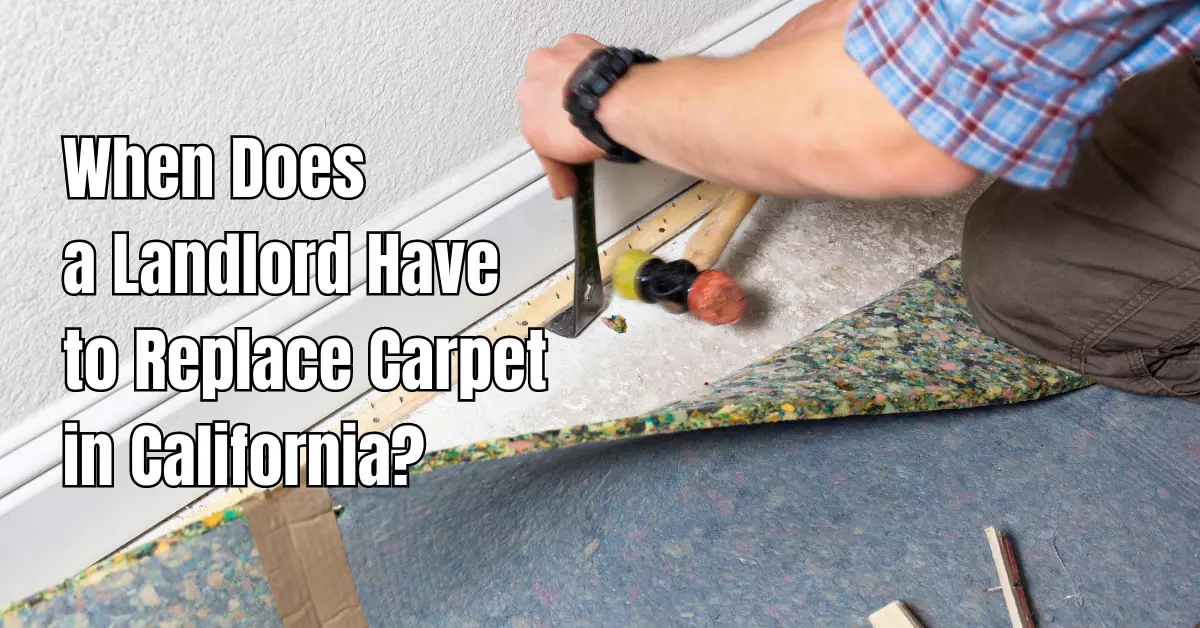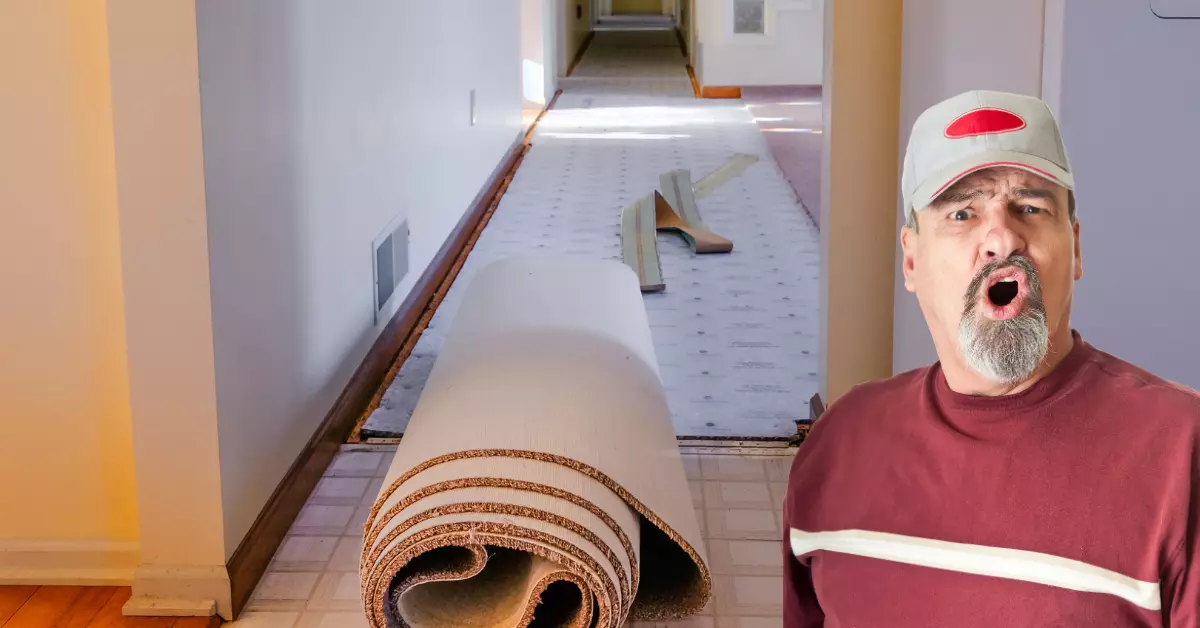When Does a Landlord Have to Replace Carpet in California?
In California, there is no specific law that mandates landlords to replace carpet at a certain time. However, landlords are generally responsible for maintaining their rental properties in habitable conditions.
This means that if the carpet becomes worn or damaged to the point where it affects the habitability of the unit, the landlord may be required to repair or replace it.
The specific circumstances that would warrant replacement would depend on factors such as the extent of the damage and the impact on the unit’s habitability.
It is recommended for tenants and landlords to refer to their lease agreement and consult with legal professionals for specific guidance in their situation.

Conditions For Replacing A Carpet In California
Landlords in California are required to maintain their rental properties to a certain standard. This includes ensuring that carpets remain in good condition throughout a tenancy.
However, it can be difficult to know when a carpet needs to be replaced, particularly if the wear and tear appear to be normal rather than tenant-related damage.
Below are some conditions that must be considered when deciding whether to replace carpets in California.
Normal Wear And Tear Versus Damage Caused By Tenants
Normal wear and tear should not be confused with tenant-related damage. It is expected that carpets will experience some wear and tear over time. Examples of normal wear and tear include:
- Fading due to sunlight exposure.
- Slight discoloration from high-traffic areas.
- Thin spots in areas where feet are placed when seated.
Damage caused by tenants, on the other hand, is different. Examples of tenant-related damage to carpets include:
- Burns.
- Rips and tears.
- Large stains that are difficult to remove.
Factors That Determine Whether The Carpet Needs To Be Replaced
Several factors will influence whether or not a carpet needs to be replaced. Some of these factors include:
- Property age: Newer carpets that are well maintained may only need minor repairs.
- Tenant turnover: If tenants change frequently, carpets can become worn out quickly and may require more maintenance.
- Type of carpet: Some types of carpet, such as Berber, are more durable than others and can better withstand high-traffic areas.
- Quality of installation: Poor installation can lead to carpets that appear worn out faster than they should be.
Age And Condition Of The Carpet
The age and condition of the carpet are important factors to consider when deciding whether to replace it. A carpet that is 10 years old or older will usually require replacement, regardless of its condition.
However, a carpet that is less than 10 years old may still be in good condition, especially if it has been well-maintained.

Extent Of Wear And Tear Or Damage
The extent of any wear and tear or damage to the carpet will also be an important factor when determining if it needs replacement.
Minor damage or wear and tear may be able to be repaired, but if the carpet is extensively damaged or worn, it may need to be replaced.
Local Health And Safety Codes
Landlords in California must comply with local health and safety codes. If the carpet poses a hazard to health or safety, it must be replaced, regardless of its age or condition.
For example, if the carpet is severely stained or infested with mold, it could pose a risk to tenant’s health and will need to be replaced.
It is essential to consider the age, condition, wear and tear or damage, and local health and safety codes when deciding whether to replace carpet in California.
This will ensure that landlords maintain the property to a high standard and provide tenants with a safe and comfortable living environment.
Legal Obligations And Requirements For Carpet Replacement
California’S Implied Warranty Of Habitability
As per California law, landlords have an implied warranty of habitability. It means they must ensure the rental unit is safe, functional, and, most importantly, habitable for tenants.
This law includes the requirement that landlords must provide clean, safe, and well-maintained carpeting in the rental unit.
What It Entails
The implied warranty of habitability in California involves several factors that landlords must adhere to. These factors include ensuring proper ventilation, providing a functional kitchen and bathroom, and maintaining safety features.
Among these requirements is the obligation to maintain clean and safe carpets for tenants.
Legal Obligations Of Landlords
Landlords in California are responsible for ensuring that the rental unit is safe, and habitable, and upholds the state’s implied warranty of habitability law.
This includes ensuring the carpet is in good condition and adequately maintained. Failure to comply with this regulation could result in legal penalties for landlords.

Limits On Security Deposits
Landlords can request security deposits from tenants before moving in. However, California laws stipulate that landlords cannot charge more than two months’ rent for an unfurnished unit or three months’ rent for a furnished unit, as a security deposit.
Overview Of California Security Deposit Laws
Under California law, landlords must return a tenant’s security deposit within 21 days of the tenant moving out of the rental unit.
The landlord reserves the right to deduct costs incurred for repair or cleaning from the security deposit, but only if such expenses occurred beyond normal wear and tear.
How Landlords May Use Security Deposits To Replace Carpets
Landlords must use the security deposit appropriately and must not withhold any part of it out of spite. If necessary, landlords may use the security deposit to replace carpets that were damaged beyond normal wear and tear during the tenant’s lease term.
However, landlords must also provide the tenant with an itemized list of all deductions made from the security deposit within 21 days of the tenant moving out of the rental unit.
FAQs for when does a landlord have to replace carpet in california?
When Do Landlords Need To Replace Carpet In California?
California landlords are legally required to replace carpet if it poses a health or safety risk to tenants.
How Often Should Landlords Replace Carpets?
Landlords should replace carpets every 5-7 years or as necessary to maintain a safe and healthy living environment.
Can Tenants Request New Carpet?
Yes, tenants can request a new carpet if it poses a health or safety risk or if it is excessively worn or damaged.
What Are The Consequences For Landlords Who Fail To Replace Carpets?
Landlords who fail to replace carpets may face legal action from tenants and could be liable for any resulting health or safety issues.
Conclusion
Navigating California’s rental laws can feel like a maze. As a tenant, know your rights. A landlord must replace the carpet if it becomes unsafe or unsanitary.
Unraveled threads, mold, or stubborn odors are your cues to request new carpeting. Remember, your comfort matters too!
Reference
https://www.courts.ca.gov/documents/California-Tenants-Guide.pdf